Basil – an aromatic herb – is a staple ingredient in many Italian dishes. It pairs well with meat and vegetables and is even added to desserts and sweet drinks. Growing this herb in European climates is possible both outdoors and indoors, in pots on a windowsill.
Basil is quite undemanding. It doesn’t require much attention from gardeners, but basic care rules, protection from diseases, and pests are still essential. Otherwise, you may encounter problems such as yellowing leaves. Learn why this happens in the article below.
Table of contents
Why Basil Turns Yellow
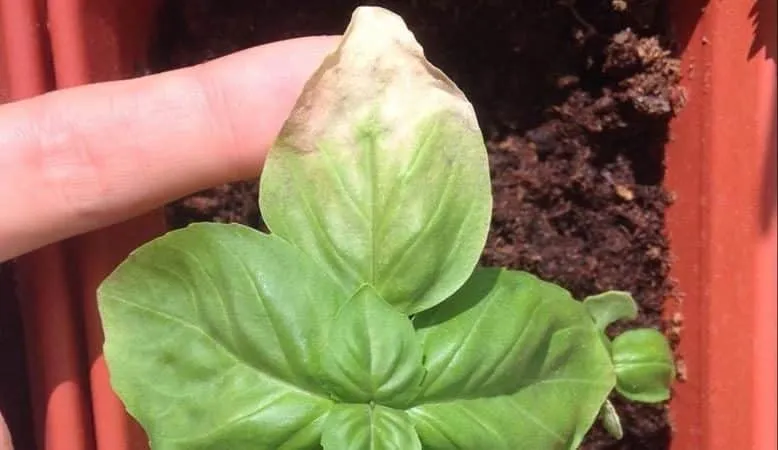
Depending on the variety, basil leaves can be green or purple. If they start turning yellow, wilting, drying, and falling off, the plant is in unfavorable conditions. The cause may lie in improper care, disease or pest infestations, or nutrient deficiencies.
To determine why basil turns yellow, look for accompanying symptoms.
Diseases
The most common reason basil dies despite proper care is infection. Several diseases can affect this aromatic herb.
Damping-off
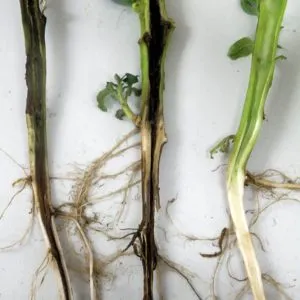
Damping-off – a fungal disease – often affects young plants. Basil grown in greenhouses or on windowsills is at the highest risk of infection.
The fungus attacks the stem base, blocking the vessels that transport water and nutrients to the plant’s cells. The fungi also release enzymes that decompose plant tissue, depriving the basil of nourishment.
Symptoms of the disease include:
- The stem base darkens, softens, and the seedling collapses.
- Leaves thin out, turn pale, and fall off.
- The plant dies.
Damping-off is incurable, so prevention is crucial:
- Excess moisture. Caused by overwatering or lack of drainage holes and a drainage layer in the pot. Waterlogged soil is ideal for fungal growth.
- Poor soil aeration. Occurs when the topsoil hardens and prevents air circulation. Loosen the soil after each watering to prevent crust formation.
- High soil acidity. Basil prefers neutral or slightly acidic soil.
If damping-off affects several plants in a seedling tray, discard all specimens in the same container. In infected greenhouse or outdoor beds, remove only the affected plants. Treat the soil with a light pink potassium permanganate solution or copper sulfate.
Note: Purple basil is more disease-resistant than green basil.
Gray Mold
Gray mold – another fungal disease – often affects basil in greenhouses and indoor settings.
Symptoms include:
- Brown, gray, or yellowish spots appear on lower leaves. At this stage, they remain dry.
- Later, the spots become water-soaked and develop a gray coating.
- The disease spreads upward, affecting all leaves.
- The plant wilts, turns yellowish, and dies.
Treat the disease with fungicides, biological agents, or home remedies.
Fusarium Wilt
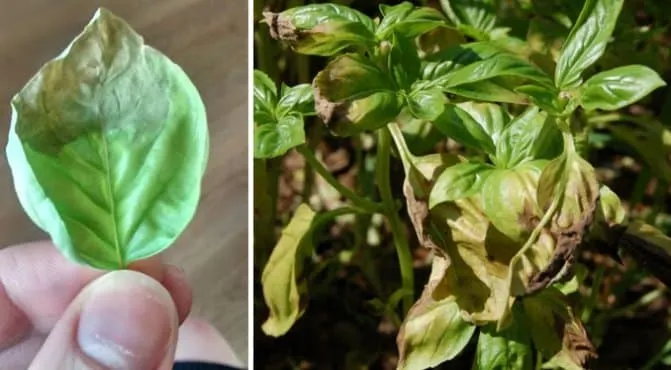
Fusarium wilt – another destructive fungal disease for basil. The pathogen releases toxins that damage the plant’s vascular system.
The disease thrives in warm, humid conditions. Fungal spores lie dormant in the soil and activate under favorable conditions, spreading to the plant.
Symptoms of fusarium wilt:
- Adult plant leaves thin out, turn pale, and yellow. Black and yellow-brown spots appear. The top of the plant dries out and dies.
- Young basil leaves thin out, take on a purple hue, and develop black or dark-yellow spots. The plant dries up and dies.
Early-stage fusarium wilt can be treated. If the disease progresses, the basil will die.
Fungicides such as "Teldor" or "Switch" effectively combat fungal diseases. However, chemicals penetrate the leaves, reducing the product’s eco-friendliness.
Basil absorbs harmful substances more than other plants, so many gardeners prefer avoiding chemicals. Biological agents like "Trichoderma" can be used instead. These contain microorganisms that destroy harmful fungi and are safer for humans and the environment.
The safest option is home remedies. They work best when applied at the first signs of disease. In advanced cases, they are less effective.
Experienced gardeners use onion peel decoction against fusarium wilt. To prepare it, mix 1 part onion peel with 4 parts boiling water. Let it steep for 2 days, strain, and spray the plants every 5 days.
Pests
Another reason basil wilts and yellows is pest infestation.
Aphids
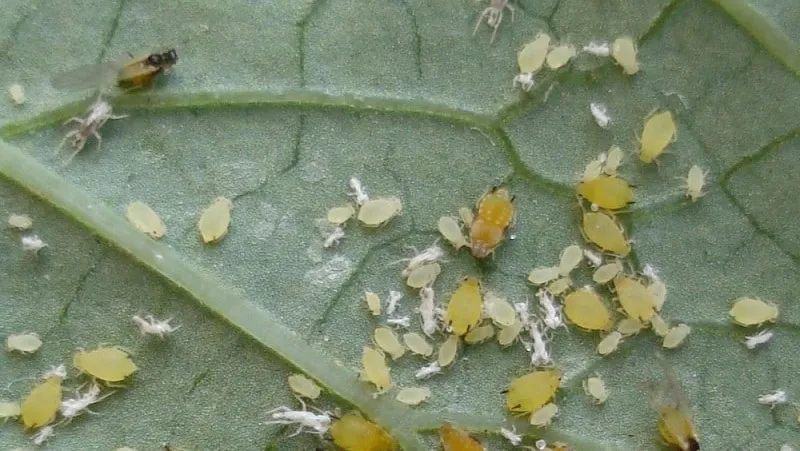
Aphids – small sap-sucking insects – colonize basil. These pests have translucent bodies in yellow, gray, green, or brown and soft exoskeletons. They drain plant sap, leading to plant death.
Aphids are easy to spot. Upon close inspection, you’ll see clusters of tiny insects, some with wings.
Aphid-infested basil leaves pale, yellow, curl, dry, and fall off. A dark, sooty mold often develops on the sticky honeydew they excrete.
Effective home remedies include infusions of hot pepper, dandelion, tomato leaves, wormwood, or onion and garlic peels. Fill a bucket one-third with the chosen plant, add boiling water, steep for 24 hours, strain, and spray.
Another proven remedy is a soap solution. Grate a bar of soap, dissolve it in a bucket of water, and spray the plants.
Spider Mites
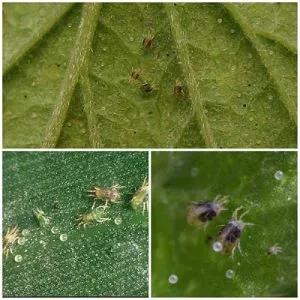
Spider mites – tiny red, black, green, or brown pests – thrive in warm, dry conditions. They feed on plant sap.
Infested basil leaves yellow, thin out, wilt, dry, and fall off. Look for webbing and tiny dots on leaf undersides.
Use the same remedies as for aphids or apply insecticides.
Snails and Slugs
Slugs and snails eat basil leaves, leaving holes and yellow, dry patches. These large pests are easily visible.
To eliminate them, locate and destroy their nests. Spray plants with an ammonia solution (one bottle per bucket of water).
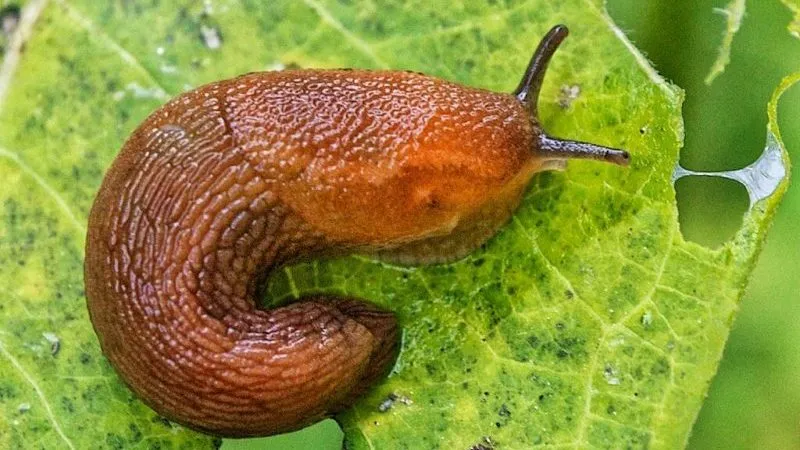
Stink Bugs
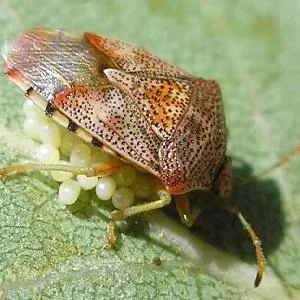
Stink bugs – shield-shaped insects in green, black, red, or yellowish – suck plant sap.
Bug-damaged leaves curl, deform, and develop yellowish spots. The basil weakens and dies.
Mix 1 kg of ash with 2 L water, boil for 30 minutes, dilute with 10 L cold water, and spray. If ineffective, use insecticides like "Pyrethrum" or "Spinosad."
Care Mistakes
If basil yellows and wilts, improper care may be the cause:
- Overwatering. Excess moisture rots roots, depriving the plant of nutrients. Common in pots without drainage.
- Underwatering. Basil is moisture-loving. Dry soil causes it to wither.
- Poor air circulation. Soil crust after watering blocks air, suffocating roots and promoting disease.
- Overcrowding. Dense plantings shade basil, causing pale, weak growth. Poor airflow increases fungal risks.
- Insufficient light. Basil thrives in sunlight. In shade, it turns pale and limp.
- Direct sunburn. Intense sunlight causes yellow-brown scorch marks.
- Unsuitable soil. Basil struggles in acidic, saline, or nutrient-poor soil.
- Weeds. They steal nutrients, weakening basil.
- Cold stress. Drafts, unhardened transplants, or icy water damage roots.
- Root damage. From rough weeding or concentrated fertilizers.
- Phosphorus deficiency. Yellow leaves with red-blue spots.
- Nitrogen deficiency. Yellow leaf tips and stunted growth.
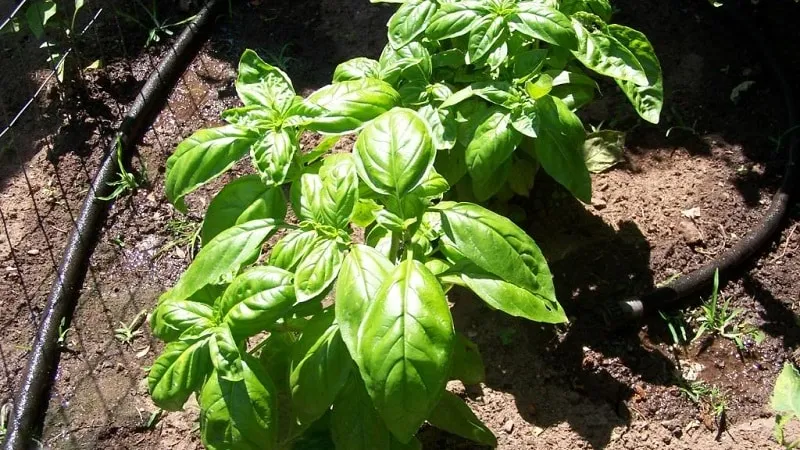
How to Save Yellowing Basil
First, inspect basil for disease or pest symptoms. Check leaf undersides for insects.
Treat infestations promptly, applying remedies to affected and neighboring plants and soil. Remove severely damaged parts.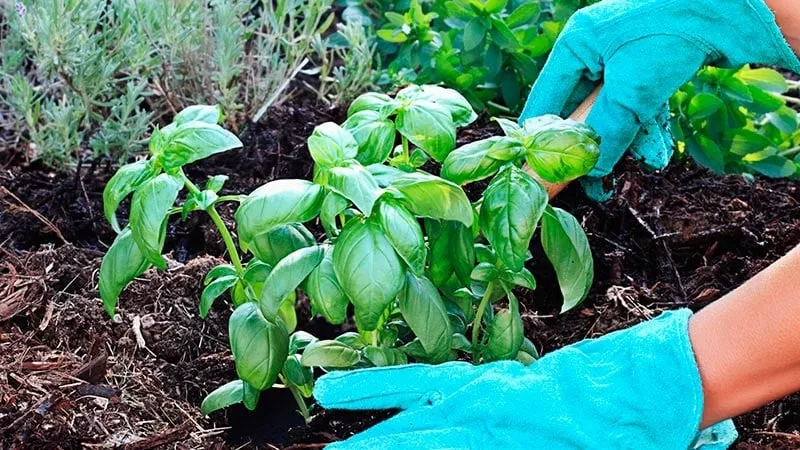
If no infections are found, adjust care. Water dry soil; let soggy soil dry and hill soil around stems to encourage new roots.
Fertilize if needed. Use phosphorus- and nitrogen-rich formulas. For severe cases, apply a growth stimulant like "Seaweed Extract."
Move shaded plants to sunnier spots or use grow lights. Outdoors, clear shading obstacles.
For cold stress or root damage, fertilize, hill soil, and water with diluted potassium permanganate. Loosen soil regularly.
What to Do if Basil Is Drying Out
Drying basil may result from aphids, spider mites, or fusarium wilt. Underwatering or root damage can also be the cause.
If most of the plant is dry, recovery is unlikely. At early stages, water with a root stimulant and weak potassium permanganate solution. Ensure adequate sunlight during recovery.
If Basil Seedlings Yellow and Collapse
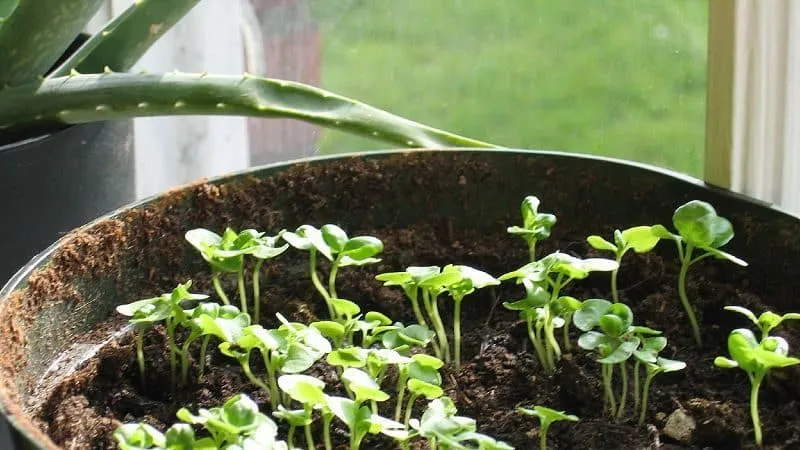
If seedlings collapse with blackened stems, damping-off is likely. Dust soil with ash and let it dry. Treat with fungicides.
Treatment isn’t always successful. If plants die, remove and burn them.
Leggy seedlings need repotting into individual containers. Water with a root stimulant ("Liquid Root Boost") and place in bright, warm light.
Note: Basil seedlings may emerge with seed coats attached, causing yellowing and death. Spray seedlings with warm water every 5 hours until the coats fall off.
Preventive Measures
Preventing yellowing is easier than curing it. Follow these guidelines:
- Sanitize. Treat soil and seeds with potassium permanganate or copper sulfate before planting. Bake soil in an oven. Disinfect gardening tools.
- Loosen soil. Aerate after watering or rain. Remove weeds.
- Fertilize. Feed every 2 weeks, alternating mineral and organic fertilizers. Water before applying.
- Water properly. Water only when soil is dry. Do so early morning or evening using room-temperature water.
- Mulch. Cover beds with straw, hay, or compost to improve airflow, prevent waterlogging, and deter pests.
- Prepare soil. Dig to a spade’s depth before planting.
- Rotate crops. Avoid planting basil in the same spot yearly. Ideal predecessors are legumes like lupins.
Conclusion
Yellowing basil leaves signal impending plant death. Causes include poor care, fungal infections, or pests. Most cases can be resolved with timely intervention.







